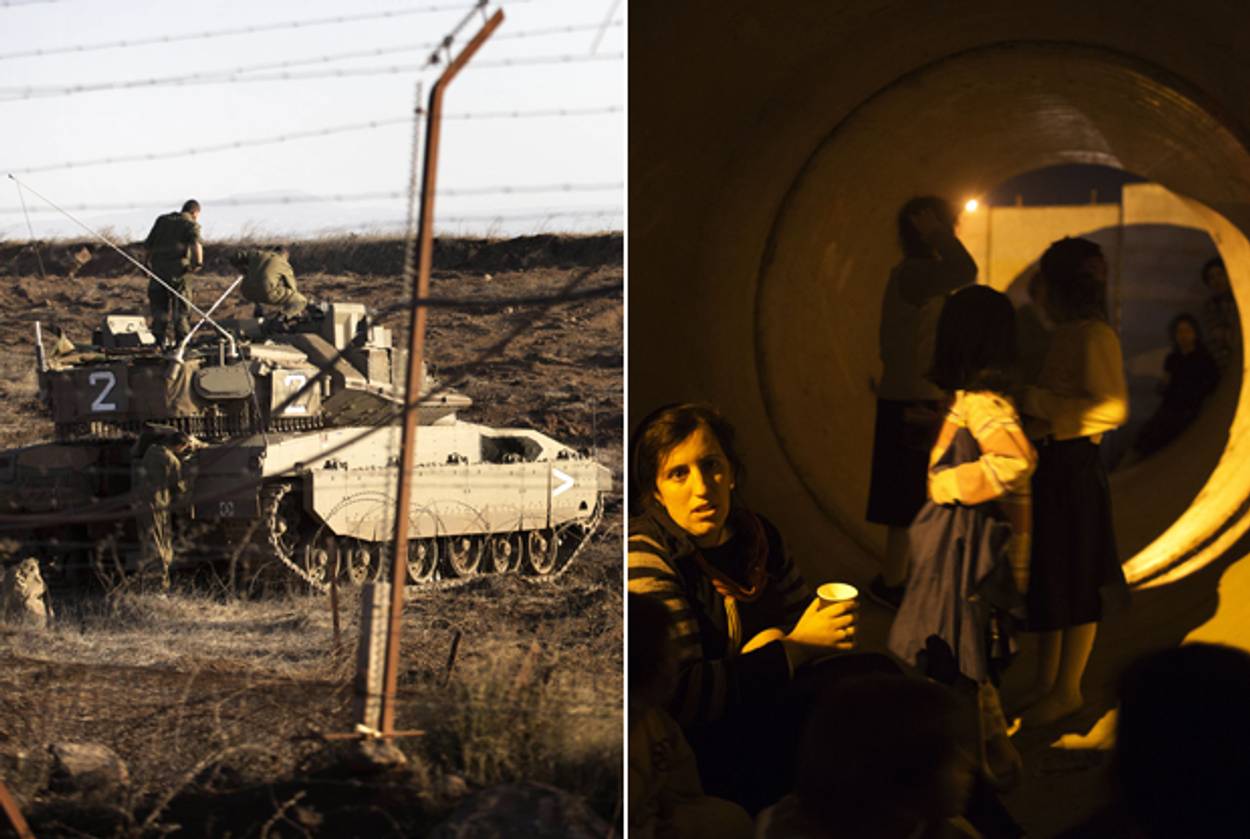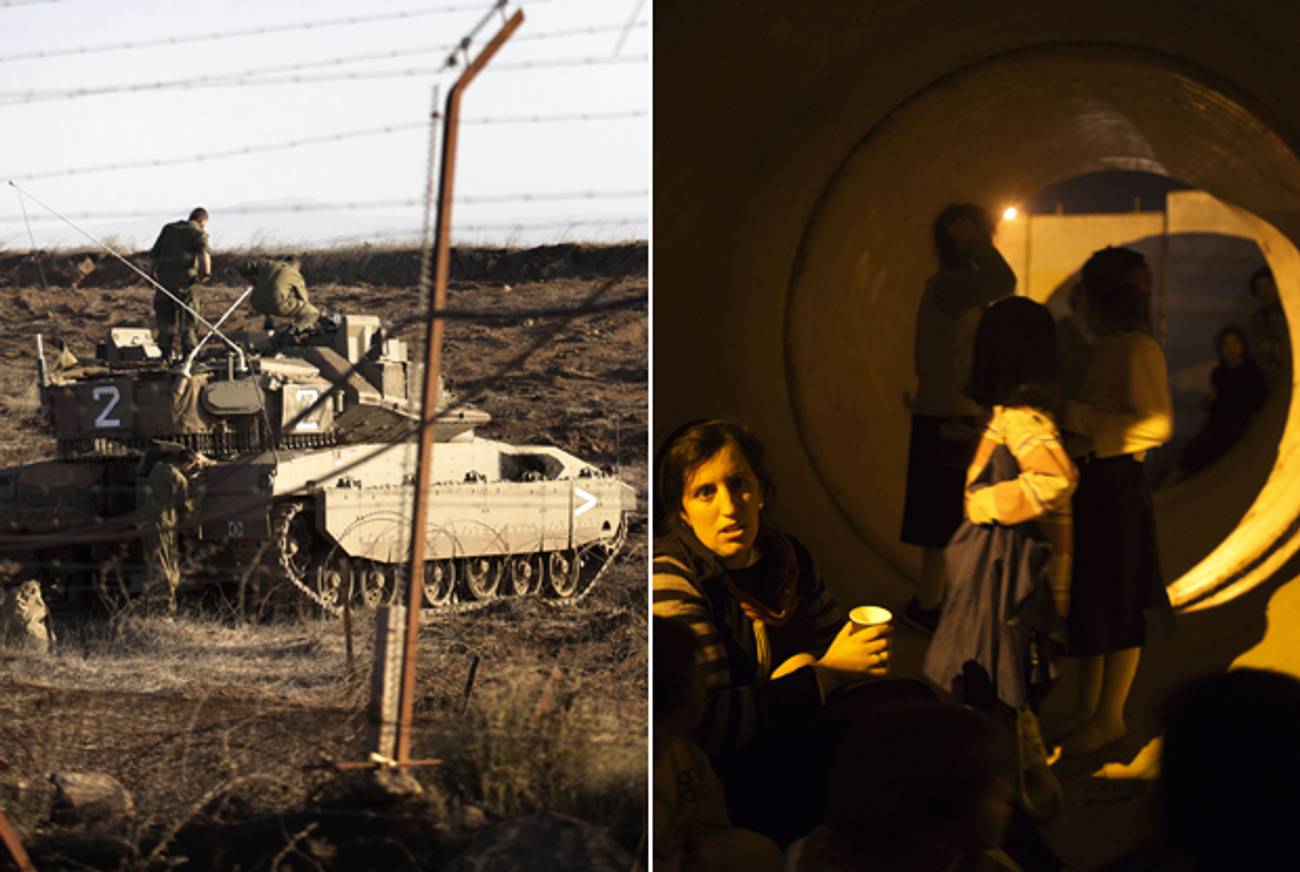Arab Upheaval Reaches Israel
The rise of the Muslim Brotherhood and the civil war in Syria are bringing violence to Israel’s borders




This week, Israel found itself targeted yet again: Missile and rocket attacks from Hamas-controlled Gaza terrorized Israelis living in towns and cities in the Negev, while on the northern border, the IDF fired a warning missile at Syria after apparently misdirected Syrian mortar fire hit the Golan Heights. The situations in Gaza and Syria are quite different, but the details of the two combined add up to picture of Israel’s dramatically changed strategic situation as a result of the upheavals in the Arab world and the advance of Sunni Islamism. These developments are heating up formerly quiet borders—and adding new, worrying dimensions to long-standing conflicts.
Though civil war has raged in Syria for 20 months, Sunday marked the first time that the conflict spilled over into Israel—and the first direct engagement of Syrian ground forces by the IDF from the Golan Heights since the Yom Kippur War of 1973. Since that year, the border has been one of Israel’s quietest. But this week, in response to mortar shells that hit the religious farming community of Alonei Bashan, Israeli gunners fired a Tammuz missile at Syrian government forces near Bir al-Ajami on the Syrian side of the Golan Heights. Then, following an additional Syrian mortar shell on Israeli soil on Monday, Israeli tanks targeted the mobile battery that had fired the mortar, injuring two Syrian soldiers.
In the south, this year has seen the highest volume of rocket attacks targeting Israeli communities since Operation Cast Lead in the winter of 2008-2009. Since January 2012, 858 rockets and mortar shells have hit Israel, compared to 676 in 2011, 357 in 2010, and 317 following Cast Lead in 2009. The deterrence gained by the IDF as a result of the operation appears to be diminishing with time, and the presence of a Muslim Brotherhood regime in Egypt is probably also contributing to Hamas’ increased boldness in Gaza.
At first blush, neither case represents a moment of supreme crisis. Israeli authorities are convinced that the stray bullets and mortar shells coming from Syria across the Golan are the result of the intensifying combat within that country rather than any attempt by the Syrian regime to draw Israel into the war. Strategic Affairs Minister Moshe Ya’alon told Israeli Army Radio Monday, “In my estimation, there is almost no doubt that (Assad) has no interest in opening a front. … All he needs now would be for us to hit him.”
Israel has now made clear to Assad that further incidents of this type will result in an Israeli response. As Ya’alon put it: “There were five incidents of supposed errant fire from small arms or mortars. We sent verbal messages. This didn’t help. So, yesterday, for the first time, we sent a physical message. If the message was understood, good. If the message was not understood, we will need to send other messages of the kind.”
In the South, Defense Minister Ehud Barak made clear on Tuesday that the current round of violence is not yet over. “Hamas and the other terrorist organizations are suffering as a result of intense strikes by the IDF in Gaza,” Barak said. “But it is certainly not over, and we will decide how and when to act if necessary.”
At this stage, any harsher Israeli response is likely to be carefully calibrated. Israel has a range of options that fall short of a paradigm-shifting major ground operation into the Strip. Airstrikes targeting Hamas facilities in response to missile attacks, which have gone on since Cast Lead, will continue. Targeting Hamas, Islamic Jihad, and other Islamist military figures may re-commence. A limited ground offensive is also an option, but it appears less likely. A major operation to unseat Hamas rule in Gaza, or even an operation at the scale of Cast Lead, remains extremely unlikely under present circumstances.
In Gaza, Sinai, and Syria, the increasing chaos is the result of a single, regional process: namely, the replacement of rotting secular Arab regimes by an energized Sunni Islamism.
In Syria, despite superior weaponry and continued support from Iran, Russia, and Hezbollah, Assad is losing ground. The strongman has money, weaponry, and international support—everything he needs for survival except for one crucial factor: people. The dictator has a steadily depleting number of men willing to risk their lives on his behalf.
This absence of reliable manpower has caused Assad to cede much of the north of Syria, and the rebels are increasing the tempo of fighting in the area south of Damascus. As the intensity of the combat in Syria’s south increases, so increases the possibility of stray shells finding their way over the border into Israel (as has happened with Turkey to Syria’s north).
The rebels remain a disparate, disunited bunch. But the Syrian insurgency is overwhelmingly Sunni, mainly rural, and devout. The growing force within it, supported by Qatar, Saudi Arabia, and Turkey, is Sunni Islamism. The statements from Free Syrian Army commanders condemning Israel’s warning shots and claiming, absurdly, that Israel had engaged on behalf of the regime have reminded Israeli policymakers that Israel has no friends on either side of the Syrian civil war. And whatever the outcome of the Syrian civil war, this new volatility is unlikely to subside for a long period to come.
To Israel’s south, the situation is defined by the advance of the Muslim Brotherhood—in Egypt, and in Gaza, in the guise of the group’s Palestinian franchise, Hamas. The presence of a Muslim Brotherhood regime in Egypt makes the notion of a major Israeli incursion into Gaza more problematic and fraught with potential dangers. Plus, at least for now, Israel considers it to be a strategic interest to prop up the shaky foundations of the peace treaty with Egypt.
All this means that the current round of violence in Gaza is likely eventually to subside back into another round of temporary, ambiguous, and relative quiet.
It’s hard to see anything optimistic in the current situation. And yet, from Israel’s point of view, one positive side effect of the rise of Sunni Islamism is the relative weakening of the Shia power of Iran. Hamas, once a client of Iran, has deserted its former patron, seeking an alliance with Sunni Egypt. The Syrian rebels, too, despise Iran, which is the main backer of the Assad regime. The key question is whether Sunni Islamist power, once it crystallizes, will prove an equally formidable challenge to Israel as is the Shia, Iran-led bloc, or whether the Sunni Islamists will prefer to focus on internal matters (and settling accounts with the Shia).
Either way, the events of the past few days on Israel’s borders have made it clear that the changing Arab political order is dictating the nature of events. The secular dictatorships that Israel vanquished on the field of battle a generation ago have departed or are departing the stage. Sunni Islamist forces are the inheritor. The result: renewed disorder and the challenging task facing the IDF of building renewed deterrence.
***
Like this article? Sign up for our Daily Digest to get Tablet Magazine’s new content in your inbox each morning.
Jonathan Spyer is a senior research fellow at the Global Research in International Affairs Center, a fellow at the Middle East Forum, and a columnist at the Jerusalem Post. He is the author of The Transforming Fire: The Rise of the Israel-Islamist Conflict.
Jonathan Spyer is a senior research fellow at the Global Research in International Affairs Center, a fellow at the Middle East Forum, and a columnist at the Jerusalem Post. He is the author of The Transforming Fire: The Rise of the Israel-Islamist Conflict.